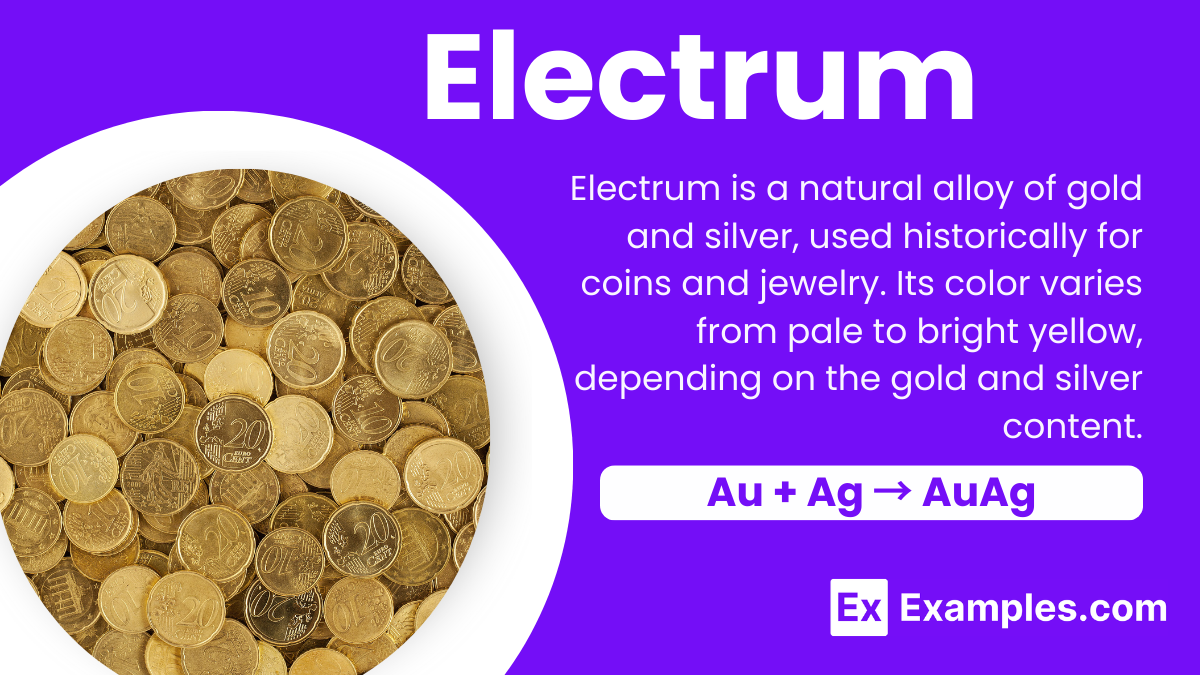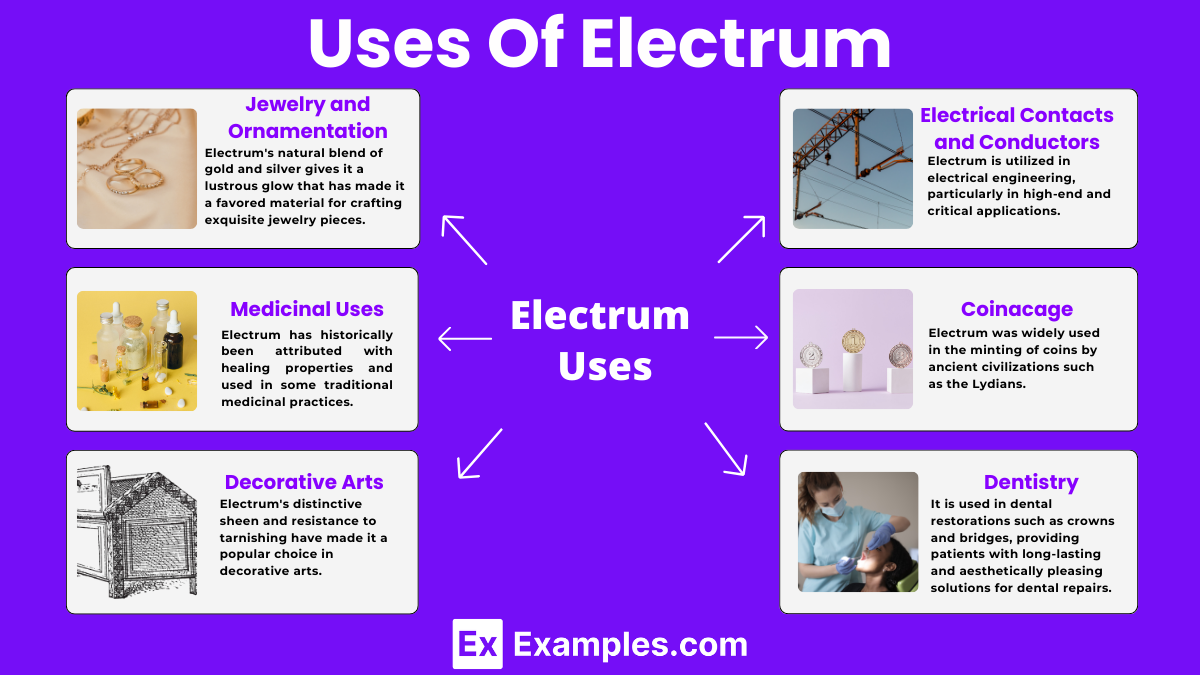What is Electrum primarily composed of?
Gold and Copper
Silver and Copper
Gold and Silver
Gold and Platinum

Electrum is a natural marvel in the world of chemistry, standing out as a unique metallic compound that has intrigued scientists and treasure hunters alike. This brilliant material is not just any metal; it’s a captivating blend of gold and silver, two of the most valued elements on earth. Imagine holding a piece of the sun and the moon in your hand—that’s what electrum embodies with its golden glow and silvery sheen. Found naturally in rivers and mines, this alloy has been used throughout history, from ancient coins to exquisite jewelry. Electrum’s composition varies, with gold usually being the dominant element, giving it that mesmerizing color and making it a subject of study in chemistry around the world. This special blend of metals not only offers a glimpse into the natural world’s wonders but also teaches us about the fascinating interactions between different elements.
Creating electrum is like making a special recipe that combines gold and silver, two of the world’s most cherished metals. To prepare electrum, you mix gold (Au) and silver (Ag) in varying proportions. Typically, you’d start with about 55% to 75% gold and 25% to 45% silver, though these ratios can change based on what properties you want the electrum to have. Here’s a simple chemical representation:
This process doesn’t require complex chemical reactions; it’s more about melting and blending these metals together until they form a uniform mixture. Once cooled, you get electrum, a beautiful, shiny alloy with a pale yellow hue, ready to be turned into coins, jewelry, or art pieces. This method of making electrum showcases the amazing ways in which different elements from the periodic table can be combined to create something valuable and unique.
| Property | Description |
|---|---|
| Color | Pale yellow, the exact shade depends on the gold-to-silver ratio. |
| Hardness | Softer than pure gold, harder than pure silver, making it durable yet malleable. |
| Melting Point | Varies between 1,062°C (1,943°F) for gold and 961.8°C (1,763.2°F) for silver; electrum’s melting point falls in between, influenced by its composition. |
| Conductivity | Excellent conductor of electricity, though slightly less than pure gold or silver due to alloying. |
| Density | Lower than gold but higher than silver; specifically, it depends on the proportion of gold and silver in the mix. |
| Luster | Has a distinctive, bright luster that can be more or less intense based on the gold content. |
Electrum mirrors gold’s impressive resistance to tarnishing and corrosion, maintaining its gleam over time. Unlike metals that react with oxygen or sulfur in the air, electrum remains largely unaffected.
Equation: Au (s) + O₂ (g) → no reaction.
Although pure gold is nearly immune to acid attacks, the silver content in electrum introduces a slight vulnerability. Nonetheless, electrum resists most acids, with exceptions like nitric acid causing reactions primarily due to its silver component.
Equation: Ag (s) + 2HNO₃ (aq) → AgNO₃ (aq) + NO₂ (g) + H₂O (l).
Electrum conducts heat efficiently, which, while not on par with pure gold or silver, is still significantly better than many other materials. This characteristic makes it useful in applications that require rapid heat transfer.
Similarly, electrum’s electrical conductivity, though slightly reduced by the alloying process, remains high. This property is particularly valued in the manufacture of electronics and electrical components, where reliable conductivity is essential.

Electrum’s natural blend of gold and silver gives it a lustrous glow that has made it a favored material for crafting exquisite jewelry pieces. Its durability and ability to hold intricate designs make it ideal for both traditional and contemporary jewelry making.
Historically, electrum was widely used in the minting of coins by ancient civilizations such as the Lydians. Its consistent composition and weight made it valuable for facilitating trade and economic transactions across vast regions.
Electrum’s distinctive sheen and resistance to tarnishing have made it a popular choice in decorative arts. It has been utilized in various forms, including small figurines, statues, furniture inlays, and architectural details, adding elegance and longevity to artistic creations.
Due to its excellent conductivity and reliability, electrum is utilized in electrical engineering, particularly in high-end and critical applications. It serves as contacts and conductors in sensitive equipment, ensuring consistent performance under varying conditions.
In dentistry, electrum is prized for its biocompatibility and durability. It is used in dental restorations such as crowns and bridges, providing patients with long-lasting and aesthetically pleasing solutions for dental repairs.
While not as common today, electrum has historically been attributed with healing properties and used in some traditional medicinal practices. Though its medicinal use has declined, it serves as a reminder of the alloy’s historical significance beyond its physical attributes.
Electrum served as a foundational element in ancient economies, being used to mint some of the earliest coins, particularly in Lydia. These coins standardized economic transactions, facilitating trade and commerce across ancient civilizations.
Electrum’s natural luster and durability have made it highly desirable for crafting jewelry. Its unique blend of gold and silver offers both aesthetic appeal and longevity, making it a preferred choice for intricate and long-lasting jewelry pieces.
Artisans and craftsmen have employed electrum extensively in artistic endeavors, embellishing artifacts, sculptures, and architectural elements. Its captivating appearance adds elegance and permanence to various artistic creations, enhancing their aesthetic appeal.
Electrum’s exceptional conductivity and resistance to corrosion make it valuable in the field of electronics. It is utilized in electrical contacts and connectors, particularly in critical and high-reliability applications, ensuring consistent performance and durability.
The dental industry harnesses electrum for its biocompatibility and durability in dental restorations like crowns and bridges. Providing both strength and aesthetic appeal, electrum offers a reliable solution for dental repairs, contributing to patients’ oral health and well-being.
In ancient times, electrum was believed to possess healing properties and was utilized in traditional medicinal practices. While not scientifically proven, this historical function highlights the cultural significance and beliefs associated with this versatile alloy.
Electrum’s value depends on its gold content, typically ranging between 60-90%. While less pure than gold, its historical significance and rarity may enhance its value.
The value of 1 electrum varies based on its gold content, market demand, and purity. It typically trades at a lower price compared to pure gold.
Cons include difficulty in determining purity, susceptibility to tarnishing, and potentially lower resale value compared to pure gold due to its mixed composition.
Electrum remains a safe investment option, but its value and security depend on factors like authentication, purity, and market conditions. Proper research and due diligence are recommended.
Text prompt
Add Tone
10 Examples of Public speaking
20 Examples of Gas lighting
What is Electrum primarily composed of?
Gold and Copper
Silver and Copper
Gold and Silver
Gold and Platinum
What ancient civilization widely used Electrum for coinage?
Romans
Greeks
Egyptians
Lydians
What is the typical color of Electrum?
Reddish
Bluish
Greenish
Pale yellow
Which property of Electrum makes it valuable in jewelry making?
High hardness
High malleability
High reactivity
High density
In addition to gold and silver, which element is commonly found in natural Electrum?
Platinum
Copper
Nickel
Zinc
What is the primary use of Electrum in ancient times?
Construction material
Currency
Agricultural tools
Weaponry
Electrum can be found naturally in which type of geological formation?
Igneous rocks
Sedimentary rocks
Metamorphic rocks
Placer deposits
What was the main advantage of using Electrum coins over pure gold or silver coins in ancient times?
Higher value
Greater durability
Easier to mint
More attractive appearance
Which modern technique is commonly used to analyze the composition of ancient Electrum artifacts?
X-ray diffraction
Atomic absorption spectroscopy
X-ray fluorescence (XRF)
Mass spectrometry
Electrum has a lower melting point compared to pure gold. What is the approximate melting point of Electrum?
1064°C
890°C
1400°C
450°C
Before you leave, take our quick quiz to enhance your learning!

